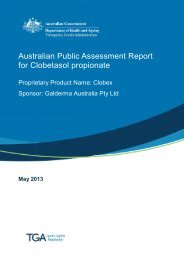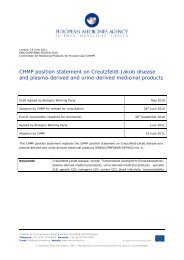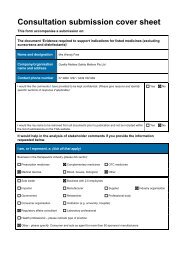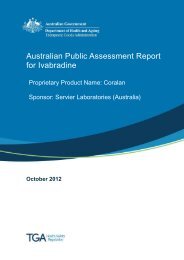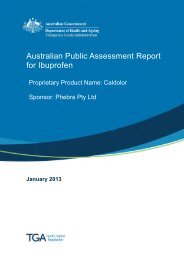AusPAR: Cabazitaxel - Therapeutic Goods Administration
AusPAR: Cabazitaxel - Therapeutic Goods Administration
AusPAR: Cabazitaxel - Therapeutic Goods Administration
You also want an ePaper? Increase the reach of your titles
YUMPU automatically turns print PDFs into web optimized ePapers that Google loves.
Figure 9: Time to first neutropenia (Grade >=3) - safety population<br />
<strong>AusPAR</strong> Jevtana <strong>Cabazitaxel</strong> Sanofi-Aventis Australia Pty Ltd PM-2010-02565-3-4<br />
Final 9 February 2012<br />
<strong>Therapeutic</strong> <strong>Goods</strong> <strong>Administration</strong><br />
The incidence of Grade ≥3 abnormalities in the Phase I/Phase II studies and in the<br />
combination study was similar to that in the pivotal study.<br />
Other safety issues<br />
Safety in special populations<br />
The TEAEs in patients < 65 years were compared with patients > 65 years. In the<br />
cabazitaxel arm, the adverse reactions reported at rates >5% higher in the > 65 year<br />
population compared to the < 65 year population included fatigue, asthenia, neutropenia,<br />
pyrexia, dizziness, urinary tract infections and dehydration.<br />
Evaluator’s overall conclusions on clinical safety<br />
The cabazitaxel arm received more cycles of intended study treatment (median 6 cycles)<br />
than the mitoxantrone arm (median 4 cycles). Both arms were equally able to receive their<br />
respective treatments as reflected by similar and high median RDIs. The incidence of<br />
TEAEs was higher in the cabazitaxel arm (95.7%) than in the mitoxantrone arm (88.4%).<br />
Of the TEAEs, there were more Grade ≥3 abnormalities in the cabazitaxel arm (57.4%)<br />
than in the mitoxantrone arm (39.4%). Similarly, the incidence of SAEs was higher in the<br />
cabazitaxel arm (39.1%) than in the mitoxantrone arm (20.8%). TEAEs including disease<br />
progression that was reported as an adverse event resulted in 18.3% in the cabazitaxel<br />
arm and 8.4% in the mitoxantrone arm discontinuing from the study.<br />
The most frequent Grade ≥3 toxicity based on laboratory values was neutropenia which<br />
was reported in 81.7% of patients in the cabazitaxel arm versus 58% in the mitoxantrone<br />
arm. The incidence of Grade ≥3 neutropenia adverse events in the TROPIC trial was 21.3%<br />
in cabazitaxel arm versus 7.0% in mitoxantrone arm. This difference was reflected in the<br />
rates of febrile neutropenia (cabazitaxel: 7.5%; mitoxantrone: 1.3%). As expected, the<br />
incidence of Grade ≥3 infections in the cabazitaxel arm (10.2%) was higher than in the<br />
Page 48 of 75





